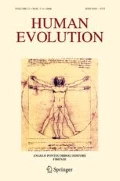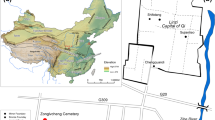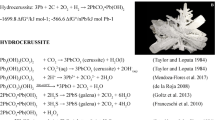Abstract
During 1993 a campaing of lithic experiments was carried out near the National Paleolithic Museum and archaeological park at Isernia La Pineta, with the aim of reproducing the morphologies of the tools found at the Paleolithic site in order to try to understand the techniques used for their manufacture and the possible uses to which they were put. In this article the results of this work are presented. The flint artifacts were faithfully reproduced using the same types of raw material used by the prehistoric artisans, and using a variety of different techniques (anvil technique, direct percussion and bipolar technique), among which the bipolar technique seems to assume a particular importance.
Of considerable interest is the fact that in the light of the experiments the denticulates and carinated becs, which at the site of Isernia La Pineta represent more than 90% of what are usually considered “tools” according to the conventional typological schemes, turned out in fact to be the residue of cores, that is flaking waste. Furthermore, flakes of small dimensions, derived from flint tablets or flakecores by means of the bipolar technique, were used as cutting tools in different possible activities and revealed their high degree of functionalism in contrast with the carinated “tools”.
The analysis of the traces of wear have shown that the great majority of these are found on the small unretouched flakes rather than on the “tools” such as the denticulates and becs, thereby demonstrating that the latter represent blanks for obtaining real tools, that are the cutting edges of unretouched flakes.
The industry from Isernia is thus shown to be very opportunistic, based on an intense exploitation of raw material and practically lacking those which, according to the conventional schemes usually adopted, can be considered as retouched “tools”.
Similar content being viewed by others
References
Accorsi C.A., 1985. The contribution of Palinology in the reconstruction of the environment. In (C. Peretto, ed.). Homo, Journey to the Origins of Man’s History, Catalogo della omonima mostra, Cataloghi Marsilio, Venezia, pp. 192–201
Anconetani P., Giusberti G. and Peretto C., 1991a. Nuovi contributi allo studio della fratturazione intenzionale dei reperti paleontologici del giacimento di Isernia la Pineta (Molise). In C. Peretto (ed.): Isernia la Pineta, nuovi contributi scientifici, Istituto Regionale per gli Studi Storici del Molise “V. Cuoco”, pp. 43–47.
Anconetani P., Giusberti G. and Peretto C., 1991b (in press). Considerations taphonomiques à propos des os du Bisonschoetensacki Freudemberg du gisement paléolithique de Isernia La Pineta (Molise, Italie). Atii 6 Table Ronde sur l’Industrie osseuse peu élaboré, Paris, 1991.
Anconetani P., Giusberti G. and Peretto C., 1991c. Su alcuni nuovi reperti di bisonte (Bison schoetensacki Freudemberg) con tracce di fratturazione intenzionale del giacimento paleolitico di Isernia La Pineta. Atti XXX Riunione Scientifica I.I.P.P., Venosa-Isernia, 1991.
Anconetani P., Crovetto C., Ferrari M., Giusberti G., Longo L., Peretto C. and Vianello F., 1992 (in press). Nuove ricerche nel giacimento di Isernia La Pineta (Molise). Riv. Sc. Preist.
Anconetani P., Ferrari M., Giusberti G., Peretto C. and Vianello F., 1993 (in press). Individuazione di una nuova paleosuperficie (t. 3s10) ad Isernia La Pineta, distribuzione dei reperti e studio archeozoologico. Atti del I Convegno Nazionale di Archeozoologia, Rovigo 5–7 Marzo 1993.
Anderson-Gerfaud P.C., Moss E.H. and Plisson H., 1988. A quoi ont-ils servi? L’apport de l’etude fonctionelle. Bull. Soc. Prehist. Franc., 84/8, pp. 99–143.
Beyries S., 1990. Problems of interpreting the functional results for ancient periods. The interpretative possibilities of microwear studies. Proceedings of the International Conference onlithic usewear analysis, 15th–17th February 1989, Upsala, Sweden, Societas Archaeologica Upsaliensis, Aun 14, pp. 71–76.
Beyries S. and Roche H., 1981. Contribution du matériel lithique de la formation Hadar à la conaissance des premieres industries: technologie et traces d’utilisation. Papier presénté au X Congres de l’U.I.S.P.P., Mexico.
Beyries S. and Roche H., 1982. Technologie et traces d’utilisation: application à des industries acheulàennes (carrières Thomas I et III près Casablanca, Maroc). Tailler! pour quoi faire: préhistoire et technologie/Recentprogress in microwear studies. In (D. Cahen and U.R.A. 28 eds.). Studia Prehistorica Belgica, Tervuren, pp. 266–275.
Bordes F., 1947. Etude comparative des differentes techniques de taille du silex et des roches dures. L’Anthropologie, t. 51, pp. 1–29.
Bordes F., 1961. Typologie du Paléolithique ancien et moyen. Delmas, Bordeax.
Borzatti von Lowenstern E., 1966. Alcuni aspetti del musteriano del Salento, Riv. Sc. Preist, XXI, pp. 204–287.
Borzatti von Lowenstern E. and Magaldi D., 1967. Ultime ricerche nella Grotta dell’Alto (S. Caterina-Nardò). Riv. Sc. Preist., XXII, pp. 205–250.
Borzatti von Lowenstern E., Sozzi M., Vannucci S. and Vianello F., 1991. L’Acheuleano del cimitero di Atella (PZ). Prime indagini sulla stratigrafia del sedimento e sulle industrie litiche, Studi per l’Ecologia del Quaternario, 12, pp. 9–29.
Bunn H.T., 1981. Archaeological evidence for meat-eating by Plio-Pleistocene hominids from Koobi-Fora and Olduwai Gorge. Nature, 291, pp. 574–577.
Bunn H.T. and Kroll E.M., 1989. Systematic Butchery by Plio/Pleistocene Hominids at Olduwai Gorge, Tanzania. Current Anthropology, 27, 5, pp. 431–452.
Coltorti M., Cremaschi M., Delitala M.C., Esu D., Fornaseri M., McPherron A., Nicoletti M., van Otterloo R., Peretto C., Sala B., Schmidt V. and Sevink J., 1982. Reversed magnetic polarity at Isernia La Pineta, a new lower paleolithic site in Central Italy. Nature, 300, 5888, pp. 173–176.
Cremaschi M. and Peretto C., 1988. Les sols d’habitat du site paleolithique d’Isernia La Pineta (Molise, Italie centrale). L’Anthropologie, 92/4, pp. 1017–1040.
Crovetto C., 1991. Resultats Preliminaires de la comparaison des industries d’Isernia La Pineta et de Venosa-Loreto. In (C. Peretto, ed.): Isernia La Pineta, nuovi contributi scientifici. Istituto Regionale per gli Studi Storici del Molise “V. Cuoco”, Isernia, pp. 79–95.
Delitalia M.C., Fornaseri M. and Nicoletti M., 1983. Datazioni argon-potassio sulla serie pleistocenica di Isernia La Pineta. In (AA. VV., ed.). Isernia La Pineta: un accampamento più antico di 700.000 anni, Catalogo della omonima mostra, Calderini Editore, Bologna, pp. 65–66.
Ferrari M., 1990. La paleosuperficie di Isernia La Pineta t.3a. Studio della distribuzione dei manufatti litici e dei reperti ossei. Tesi di laurea, Università di Ferrara, dattiloscritto inedito, pp. 1–253.
Ferrari, M., Peretto C. and Vianello V., 1991a. Aspetti tecno-tipologici e distribuzione areale dell’industria litica del II settore di Isernia La Pineta (Molise, Italia). In (C. Peretto, ed.). Isernia La Pineta, nuovi contributi scientifici. Istituto Regionale per gli Studi Storici del Molise “V. Cuoco”. Isernia, pp. 49–78.
Ferrari M., Peretto C. and Vianello F., 1991b (in press). L’industria litica del II settore di scavo di Isernia La Pineta (Molise), Italia: caratteri tecnico-tipologici e distribuzione areale dei reperti. Atti XXX Riun. Scient. I.I.P.P., Venosa ed Isernia, 1991.
Ferrari M., Peretto C. and Vianello F., 1992. Etude et interpretation des industries lithiques du gisement paleolithique de Isernia La Pineta (Molise, Italie Centrale). 3o Congres International de Paléontologie Humaine, Jerusalem, Book of abstracts, Journal of the Israel Prehistoric Society, p. 35.
Frison, C.G. 1979. Observations on the use of stone tools: dulling of working edges of some chipped stone tools in Bison butchering. In (B. Hayden, ed.) Lithic Use-wear Analysis, New York, Academic press, pp.256–268.
Giusberti G., Guerreschi A. and Peretto C., 1983. Le struture d’abitato del giacimento paleolitico di Isernia la Pineta. Prime considerazoni. In C. Peretto et al. (eds.): Isernia La Pineta, un accampamento più antico di 700.000 anni, Calderini Editore, Bologna, pp.95–103.
Giusberti G., Ferrari M. and Peretto C., 1991. Tipologia, frequenza e distribuzione dei reperti paleontologici e paletnologici della paleosuperficie t.3a del I settore di scavo di Isernia La Pineta (Isernia, Molise). In (C. Peretto, ed.). Isernia La Pineta, nuovi contributi scientifici. Istituto Regionale per gli Studi Storici del Molise “V. Cuoco”, Isernia, pp. 5–41.
Giusberti G. and Peretto C., 1991. Evidences de la fracturation intentionnelle d’ossements animaux avec moelle dans le gisement paléolithique de La Pinetade Isernia (Molise, Italie). L’Anthropologie, 96, pp. 765–778.
Giusberti G., Ferrari M. and Peretto C. 1992 (in press). Struttura della paleosuperficie t. 3a del I settore di scavo di Isernia la Pineta (Molise). Atti XXX Riunione Scientifica I.I.P.P., Venosa-Isernia 1991.
Grace R., 1989. Interpreting the function of stone tools. The quantification and computerization of microwear analysis. BAR, International Series, 474, Oxford.
Isaac G., 1984. The archaeology of human origins: studies of the lower pleistocene in east Africa 1971–1981. Advances in world archaeology. 3, Academic press, pp. 1–87.
Keeley, L.H., 1977. The functions of paleolithic flint tools. Scientific American, 237/5, pp. 108–126.
Keeley, L.H. and Toth N., 1981. Microwear polishes on early stone tools from Koobi Fora, Kenya. Nature, 293, 8, pp. 108–126.
Laj Pannocchia F., 1950. L’industria pontiniana della Grotta di S. Agostino. Riv. Sc. Preist., 5, 1/4, pp. 67–86.
Laplace G., 1964. Essai de typologie systématique. Annali Università of Ferrara, sez. 15, suppl. 2 al vol. 1, pp. 1–85.
Leakey M.D., 1971. Oiduvai George. Excavations in beds I & II, 1960–1961. Cambridge University Press.
Levi-Sala I., 1986. Use-wear and post depositional surface modification: a word of caution. Jour. of Arch. Sc., 13, pp. 229–244.
Longo L., 1991. Ergonomia ed economia delle popolazioni preistoriche. Analisi delle tracce d’uso di manufatti litici. Tesi di Dottorato di ricerca. Università di Ferrara.
Lumley de H. and Bottet B., 1960. Sur l’évolution des climats et des industries au Riss et au Vurm d’après le remplissage de la Baume-Bonne (Quinson, Basses-Alpes). Festschrift fr Lothar Zotz. Bonn.
Mansur M.E., 1982. Microwear analysis of natural and use striations: new clues to the mechanism of striation formation. Studia Prehistorica Belgica, 2, pp. 213–233.
Mansur-Franchomme M.E. 1986. Microscopie du materiel lithique préhistorique: traces d’utilization, alterations naturelles, accidentelles et technologiques. Cahiers du Quaternaire, 9, C.N.R.S. ed.
McPherron NA. and Schmidt V. 1983. Paleomagnetic dating at Isernia La Pineta. In (AA. VV. eds.). Isernia La Pineta: un accampamento più antico di 700.000 anni. Catalogo dell’omonima mostra. Calderini Editore, Bologna, pp. 67–69.
Moss E.H. 1983. Some comments on the edge damage as a factor in functional analysis of stone artifacts. Jour. of Arch. Sc., 10, pp. 231–242.
Newcomer M.H., 1976. Spontaneus retouch. Staringia, 3, pp. 62–64.
Newcomer M.H., 1980. Savoir utiliser les outils prehistorique. Dossier de l’Archeologie, 46, pp. 18–22.
Odell G.H., 1980. Butchering with stone tools. Some experimental results. Lithic Technology, IX/2, pp. 39–47.
Peretto C., 1983. Le industrie litiche di Isernia La Pineta. In (AA. VV. eds). Isernia La Pineta: un accampamento più antico di 700.000 anni. Catalogo della omonima mostra. Calderini Editore, Bologna, pp. 81–93.
Peretto C., 1987. L’origine du peuplement humain en Italie: les aspects culturels. II Congres International de Paleontologie Humaine, Table ronde: Homo erectus, Torino, pp. 125–127.
Peretto C. (ed.), 1991. Isernia La Pineta, nuovi contributi scientifici. Istituto Regionale per gli Studi Storici del Molise “V. Cuoco”, Isernia.
Peretto C. (ed.), 1992. I primi abitanti della Valle Padana: Monte Poggiolo. Le Origini dell’Uomo, Jaca Book, vol. 304, pp. 1–365.
Peretto C. and Piperno M., 1985. L’origine del popolamento umano in Italia. In C. Peretto (ed.): Homo, viaggio all’origine della storia, Marsilio Editore Venezia, pp.82–89.
Peretto C., Terzani C. and Cremaschi M. (eds.), 1983. Isernia La Pineta: un accampamento più antico di 700.000 anni. Catalogo della omonima mostra, Museo Archeologico Nazionale di S. M. delle Monache, Isernia, Calderini editore, Bologna.
Pescatore T., 1965. Ricerche geologiche sulla Depressione Molisano-Sannitica. Atti Ac. Sc. Fis. e Nat., III, 5, 4, pp. 101–145.
Plisson H., 1983. De la conservation des micropolis d’untilisation. Bull. Soc. Prehist. Franc., 80/3, pp. 74–77.
Plisson H. and Maugher M., 1988. Chemical and mechanical alteration of microwear polishes: an experimental approach. Helinium, XXVIII/1, pp. 3–16.
Sala B., 1983. La fauna del giacimento di Isernia La Pineta: nota preliminare. In C. Peretto et al., Isernia La Pineta: un accampamento più antico di 700.000 anni. Catalogo della omonima mostra, Museo Archeologico Nazionale di S. M. delle Monache, Isernia, Calderini editore, Bologna, pp. 71–79.
Sala B., 1986. Bison schoetensacki Freudemberg from Isernia La Pineta (Early Mid-Pleistocene — Italy) and revision of the European species of Bison. Paleontographia Italica, 74 (1986), pp. 113–170, Pisa.
Sala B., 1990. Panthera leo fossilis (V. Reich, 1906) (Felidae) de Isernia La Pineta (Pleistocène Moyen Inferieur d’Italie). Geobios, 23 (2), pp. 189–194, Lyon.
Sala B. and Fortelius M., 1993. The rhinoceroses of Isernia La Pineta (early Middle Pleistocene, Southern Italy). Paleontographia Italica, 80, pp. 157–174.
Tonon M., 1989. Note sull’avifauna del deposito di Isernia La Pineta. Il Quaternario, 2, pp. 171–173.
Toth N., 1987. La più antica tecnologia. Le Scienze, 226, pp. 102–113.
Author information
Authors and Affiliations
Rights and permissions
About this article
Cite this article
Crovetto, C., Ferrari, M., Peretto, C. et al. The carinated denticulates from the Paleolithic site of Isernia La Pineta (Molise, Central Italy): Tools or flaking waste? The results of the 1993 lithic experiments. Hum. Evol. 9, 175–207 (1994). https://doi.org/10.1007/BF02437926
Received:
Accepted:
Issue Date:
DOI: https://doi.org/10.1007/BF02437926




